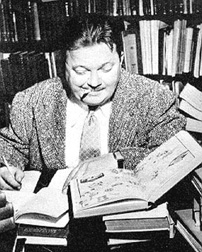
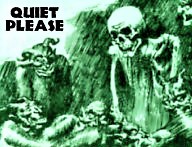 Quiet, Please (1947-49) aired “The Oldest Man in the World” on May 21, 1949 as its 101st episode.This is the 7th Quiet, Please we’ve run since 2009 and the first since 2017, well over 7 years ago, so a reprise of the backstory of this fondly remembered horror program is in order.
Quiet, Please (1947-49) aired “The Oldest Man in the World” on May 21, 1949 as its 101st episode.This is the 7th Quiet, Please we’ve run since 2009 and the first since 2017, well over 7 years ago, so a reprise of the backstory of this fondly remembered horror program is in order.
Scripts were written and directed by Wyllis Cooper (1899-1955, photo at right), who was also responsible for one of early radio’s most acclaimed horror shows Lights Out (1934-47). After the first year or two, and having established Lights Out as a winner, Cooper left radio for Hollywood and turned the show over to radio wunderkind Arch Oboler. While in Hollywood, Cooper is most noted for the screenplay of Son of Frankenstein (1939), the third in the Frankenstein series (behind Frankenstein {1931} and Bride of Frankenstein {1935}) and the last to feature Boris Karloff as the monster. While not the best of the Frankenstein movies, it did feature Basil Rathbone as Baron Frankenstein (grandson of the original Dr. Frankenstein), and introduced Ygor (played by Bela Lugosi) as the deformed blacksmith who had survived a hanging for the crime of grave robbing, and as a result now shuffles along as a hunchback.
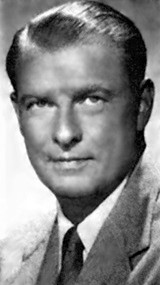 Cooper’s format for Quiet Please was quite different than the idea behind Lights Out. While the latter was more splashy and gory and came to be known (and loved) for its grisly sound effects, Quiet Please went in the opposite direction. Cooper relied on his scripts to tell the story and many OTR historians now praise the solid writing, even though production values were quite minimal. Often there were only three characters, with narrator Ernest Chappell (1903-1983, photo at left) having a part while at the same time narrating story details directly to the audience. There was also no music score to speak of, only the ubiquitous organ riffs so prevalent in early radio. Script and story were everything.
Cooper’s format for Quiet Please was quite different than the idea behind Lights Out. While the latter was more splashy and gory and came to be known (and loved) for its grisly sound effects, Quiet Please went in the opposite direction. Cooper relied on his scripts to tell the story and many OTR historians now praise the solid writing, even though production values were quite minimal. Often there were only three characters, with narrator Ernest Chappell (1903-1983, photo at left) having a part while at the same time narrating story details directly to the audience. There was also no music score to speak of, only the ubiquitous organ riffs so prevalent in early radio. Script and story were everything.
This past week (as I type) has seen most of the United States, from the midwest to the east coast, battered with an historic ice and snow storm, breaking records for ice and snow accumulation in several states, and in some areas graduating to full blown blizzard status, all accompanied by sub-zero temperatures for days. With this in mind I felt “The Oldest Man in the World” somewhat apropos in that it takes place in the Pyrenees mountains bordering France and Spain, with the backstory beginning some 20,000 years ago after the glaciers had receded and Cro-Magnon man had lived and died, setting the stage for the current tale. The present drama concerns a few friends visiting a large cave high in the mountains where they find a fully formed human footprint encased in the millennia-old rock floor in the back of the cave, near a large, dark hole in the cave floor. A dangerous sequence of events soon transpire as two of the group learn the hard way just what resides at the bottom of the hole, and why this episode is given the title of “The Oldest Man in the World.”
Play Time: 29:29
{With only a week or two remaining in the school year when this episode was broadcast on a Saturday evening in late May of 1949, the neighborhood gang listened with rapt attention for the secrets this story held for them. It was a good finish to a satisfying day, for they picked up several quality pulps from the nearby newsstand that afternoon to help tide them over for the rest of the weekend. Action Stories (1921-1950) has been extolled as “one of the great multi-genre pulps.” It ran for an amazing 224 issues and for its first 10 years was a reliable monthly. It slowed down a bit to a sporadic bi-monthly schedule for the next 10 years or so and then became a quarterly in the middle of WWII until its demise with its Summer 1950 issue. Though labeled as a multi-genre (detective, mystery, adventure) publication it ran more western adventure stories than any other type. Blue Book (1905-1956) was one of longest lived of the early golden era of multi-genre magazines. Its first many years were devoted to a young female audience, with a variety of stories centered around love, marriage, divorce, and home life, a few spicing things up with detective and mystery themes focused around women. That said, over time, they would feature stories by the likes of Agatha Christie and Zane Grey, when either of them would come up with something new. A few pirate stories, western expansion across the United States adventures, colorful tales of conquistadors battling native peoples from various indigenous locales even made it within Blue Book’s pages, along with action-filled page-turners set in revolutionary times, all designed hopefully to expand the reading tastes of its ever-growing audience. It was a monthly throughout it history. Private Detective (1937-1950), so says the site I use frequently for information about the pulps, began its life in the vein of the earlier “spicy” magazines (Spicy Detective, Spicy Mystery) of three years previous, but with less lurid covers and not quite as much of the stark, unforgiving, “psychopathology” of the pulps it emulated. Like Blue Book, Private Detective was a monthly throughout its somewhat controversial life.}
[Left: Action Stories, Spring/49 – Center: Blue Book, 5/49 – Right: Private Detective, 4/49]
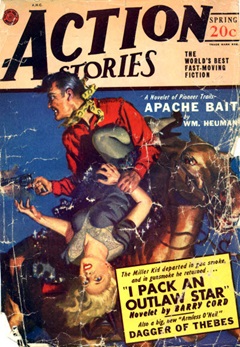
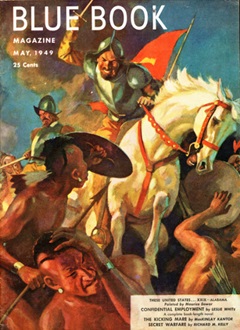
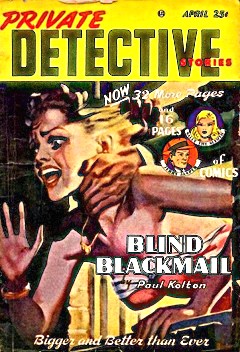
To view the entire list of weekly Old Time Radio episodes at Tangent Online, click here.